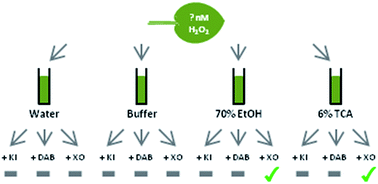A comparison of colorimetric assays detecting hydrogen peroxide in leaf extracts†
Abstract
Hydrogen peroxide (H2O2) is a central molecule in plant stress responses as a potential oxidizing agent or a signal molecule, depending on its localization and cellular concentrations. The present work compares three colorimetric assays assessing H2O2 concentrations in terms of sensitivity, linearity with increasing H2O2 concentrations, solvent interactions and recovery of exogenous H2O2 from leaf extracts. The tested methods were based on the oxidation of one of the following chromophores: potassium iodide (KI), 3,3′-diaminobenzidine (DAB) or xylenol orange (XO). Various solvents were chosen for extraction to represent two different approaches of sampling: extraction into water or water-based buffer providing material for an array of bioassays and extraction into solutions containing trichloroacetic acid (TCA) or ethanol in order to minimize interactions arising from leaf biochemistry. The most employable technique was the xylenol orange assay in organic solvents, although it is advisable to interpret results against a series of spiked samples rather than a calibration line acquired in solvents only.



 Please wait while we load your content...
Please wait while we load your content...